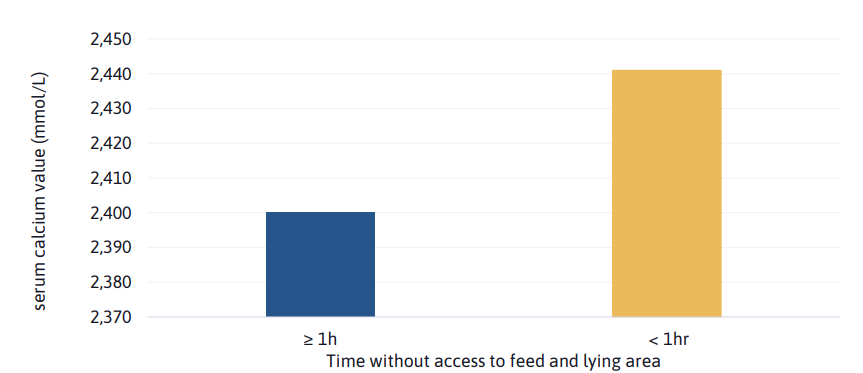Poster
Restriction of free access to feed and resting area after last milking before dry-off associated with lower blood calcium levels in dairy cows
Authors
Andrew Biggs (The Vale Veterinary Group – Devon United Kingdom); Peter Keyte (Ceva Animal Health - London United Kingdom); Maria Pimenta (CITAB - Centre for the Research and Technology of Agro-Environmental and Biological Sciences - Vila Real, Portugal); António Silvestre (Trás-os-Montes and Alto Douro University – Vila Real, Portugal); Ângela Martins (Trás-os-Montes and Alto Douro University – Vila Real, Portugal); Juan Munoz Bielsa (Ceva Santé Animale, Libourne, France); Carla Azevedo (Ceva Saúde Animal, Lisbon, Portugal)
Publication information
World Buiatric Congress 2022
OBJECTIVES
A recent publication has emphasized the fact that subclinical hypocalcaemia can be found in dairy cows immediately following dry-off (Krogh et al., 2018) and the condition of atypical milk fever (clinical hypocalcaemia in late gestation) has been described before (Radostitis et al., 2007). Despite considerable research into dry cow management and the increasing level of milk production at dry-off in the modern cow, there is limited information available on the prevalence of hypocalcaemia at dry-off and potential associated risk factors. This study aims to assess the prevalence of subclinical hypocalcaemia after the last milking before dry-off in dairy cows in United Kingdom. Additionally, to evaluate the effect of the restriction of access to feed and lying area on the mean serum total calcium value at this stage of the lactation cycle.
MATERIALS AND METHODS
A total of 15 farms selected across South West UK participated in the study. Within these farms, 197 cows were included in the study follow-up between the 22nd of November, 2018 and the 28th of February, 2019. For all cows, information was recorded regarding the time without free access to feed and lying area after last milking. Blood samples were collected 8-12h after their last milking before dry-off and sent to a reference laboratory. Subclinical hypocalcaemia was considered when cow blood calcium was <2.200 mmol/L. Statistical analysis was performed using the computer software JMP (version 7) SAS Institute.
RESULTS

Overall, 67% (132/197) of cows were without access to feed or lying for ≥ 1 hour after their last milking before dry-off. Analysis of serum total calcium demonstrated that 2% of cows had hypocalcaemia (5/197) 8-12 hours after their last milking before dry-off. Statistical analysis demonstrated that cows with ≥ 1h without access to feed and lying area had a significantly lower mean serum calcium value (mmol/L) 8-12 hours after their last milking before dry-off compared to those that were without access to feed and lying area for < 1hr (2.400 vs. 2.441, P=0.018).
CONCLUSIONS
This study demonstrates that subclinical hypocalcaemia in dairy cows after dry-off occurs in United Kingdom, and that restriction of access to feed and lying area increases the likelihood of lower blood calcium level of cows in the hours after dry-off.
Don´t hesitate to read the rest of our publicatons and improve your knowledge about ruminats and their health!
Publication file:



